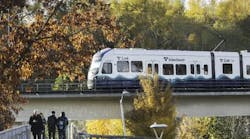Sound Transit selects route and station locations for West Seattle Link Extension
The Sound Transit Board has selected the route and station locations for the West Seattle Link Extension. The action authorizes the project to move forward into the final design phase and establishes the project definition for the NEPA Record of Decision (ROD). Sound Transit notes that when the ROD is issued, the federal environmental review process will be complete and the project can proceed. The milestone is expected in late 2024 and construction on the project is expected to begin in 2027.
In conjunction with publication of the Final Environmental Impact Statement (EIS) in September, Sound Transit updated the cost estimate for the West Seattle Link Extension to between $6.7 and $7.1 billion. In response to this significant increase, the Sound Transit Board passed Motion M2024-59, directing the agency to develop a workplan to improve the agency’s financial situation and move WSLE through design to inform a financially sound project to be baselined. The agency says the workplan will include programmatic, financial and project-level measures.
“Today marks an important milestone in delivering light rail to west Seattle,” said Sound Transit Board Chair and King County Executive Dow Constantine. “Through the board-directed work plan, our action today allows Sound Transit to use the design process to address cost pressures, reduce impacts and prepare projects for construction, fulfilling our promise to the voters. I want to thank everyone who has engaged with us throughout the planning process to-date.”
The West Seattle Link Extension was approved by voters in 2016 as part of the ST3 plan. The project will extend light rail 4.1 miles and serve four new stations (at SODO, Delridge, Avalon and the Alaska Junction) to provide fast, reliable light rail connections in the SODO, Delridge and west Seattle neighborhoods.
Sound Transit notes trips between Alaska Junction and Westlake stations will take 16 minutes during peak hours, a 50 percent reduction from current travel times. The extension will improve overall transit service frequency, reliability and capacity; facilitate redevelopment, including affordable housing near stations; and provide a travel alternative when the West Seattle Bridge is congested or unavailable.
“A safe, connected, and well-maintained transit system is a top priority for my administration and Sound Transit 3 represents the largest infrastructure program in Seattle’s history. We must also match our ambitions with accountability,” said Sound Transit Board Member and Seattle Mayor Bruce Harrell. “As a board, our role is to ensure that construction impacts and rising costs do not overly burden [the] community, as we work to deliver these transformative projects. Today's approved action on the West Seattle Link Extension route and stations is a forward step in helping us meet our challenges and getting us closer to providing reliable transit for generations to come.”
The final alignment selected by the board is the Final EIS Preferred Alternative:
- West Seattle Junction segment: Medium Tunnel 41st Ave. Station West Entrance Station Option
- Delridge segment: Andover Street Station Lower Height South Alignment Option
- Duwamish Segment: South Crossing Alternative
- SODO segment: At-Grade Lander Access Station Option
Sound Transit says the alignment selected incorporates refinements requested by the Sound Transit Board when it identified the preferred alternative in 2022. Working with community members, the city of Seattle and King County staff studied these project features to enhance station access, prioritize an integrated and well-designed transfer experience from buses to light rail and address concerns over potential displacements of organizations serving low-income and communities of color.
“Today’s action gives Sound Transit the green light to move forward on West Seattle Link Extension’s final design, to study ways to contain costs and to work further on avoiding or mitigating the impacts of this major construction project in the neighborhoods it will serve,” said Sound Transit System Expansion Committee Chair and King County Councilmember Claudia Balducci. “We’ve worked hard to get to this point and I remain committed to deliver the fast, frequent and reliable transit we promised the voters as quickly and affordably as possible.”
Sound Transit notes the board’s approved resolution included an amendment to move forward with the development and implementation of the workplan to improve the agency’s financial situation and move the West Seattle Link Extension through design. The amendment also directed the agency to continue working to reduce identified project impacts during the design phase and advancement of the workplan to achieve cost savings and to minimize community impacts in SODO and west Seattle while continuing to provide enhanced transit integration and station access and engaging with impacted residents and businesses.
“With the West Seattle Link extension, Sound Transit is entering a new era of designing and building capital projects,” said Sound Transit Interim CEO Goran Sparrman. “As we begin to implement the workplan and address cost pressures, we will be engaging with the construction industry sooner to identify the best way to approach our projects and developing ways to create greater efficiencies once we enter construction. These innovations will not only help the WSLE project, but support advancing other projects in the expansion program.”
The agency will return to the board in the future as design progresses and authorize construction dollars. More information on the West Seattle Link extension can be found on Sound Transit’s website.



